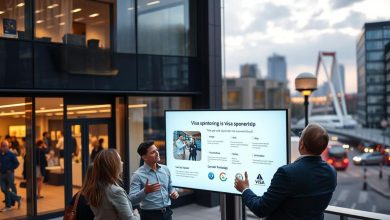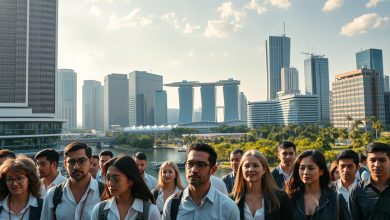Visa Sponsorship in South Korea: Key Benefits, Application Process.
Anúncios
Navigating employment opportunities abroad requires understanding local systems.
In this East Asian nation, foreign workers engage through the Employment Permit System (EPS), a structured framework replacing traditional sponsorship models. Employers must partner with overseas employment centers to invite talent, prioritizing transparency and compliance.
Legal adherence is critical for both businesses and workers. Non-compliance risks fines, operational disruptions, or even legal action. The EPS streamlines hiring for roles ranging from tech specialists to agricultural professionals, creating pathways for diverse skill levels.
This guide breaks down application steps, required documents, and sector-specific prospects. Readers will learn how to leverage the system for career growth or workforce expansion. With clear processes and strategic planning, international professionals and companies can thrive in this innovation-driven economy.
Understanding South Korea’s Immigration Landscape
Global professionals entering the East Asian workforce encounter meticulously designed frameworks governing foreign labor. The system integrates labor standards, tax codes, and residency rules, demanding careful navigation for sustainable employment.
Regulatory Architecture and Enforcement
Three primary agencies oversee foreign worker management: the Ministry of Justice handles residency permits, the Ministry of Employment coordinates labor quotas, and local governments enforce workplace standards. Employers must submit:
- Valid business registration certificates
- Detailed employment contracts
- Proof of salary compliance
Quarterly audits verify adherence to minimum wage laws and working hour limits. Recent reforms mandate digital submission of all foreign employee records through the GOV.KR portal.
Consequences of Non-Compliance
Authorities impose escalating penalties for violations. First offenses typically incur fines up to ₩20 million ($15,000), while repeat offenders face operational suspensions. Criminal charges apply for deliberate fraud or exploitation cases.
Businesses maintaining clean records gain priority processing for future hiring applications. Proactive compliance strategies include monthly internal reviews and staff training on updated policies.
Visa Sponsorship South Korea: Scope, Benefits, and Eligibility
The framework for international employment in this East Asian nation offers structured pathways for both skilled professionals and essential industry workers. Clear guidelines ensure alignment between foreign talent and domestic workforce needs while maintaining equitable standards.
Eligibility Criteria for International Workers
Requirements differ across visa categories. Professional roles demand advanced degrees or certifications, such as E-1 (Professor) or E-5 (Professional Employment) classifications. Non-professional work permits prioritize applicants willing to fill labor gaps in agriculture or manufacturing.
Short-term options like the C-3-4 permit cater to business consultants, while the H-1 category supports temporary cultural exchanges. Language instructors under E-2 visas must provide teaching credentials and clean criminal records.
Key Benefits for Employers and Employees
Workers gain access to national healthcare, pension plans, and legal protections against workplace discrimination. Competitive salaries often exceed home-country averages, particularly in tech and engineering sectors.
Companies benefit from streamlined hiring processes through the Employment Permit System. This reduces recruitment costs while securing specialized skills for projects. Long-term work permits enable businesses to retain top talent, fostering innovation and market growth.
Exploring Work Visa Options and Categories in South Korea
Foreign professionals exploring career opportunities encounter a structured framework tailored to diverse industries and skill levels. The system offers three primary pathways for legal employment, each addressing specific economic priorities while maintaining workforce balance.
Professional, Non-Professional, and Business Visa Types
Highly skilled experts qualify for professional permits like the E-1 (Professors) and E-2 (Language Instructors). These roles require advanced degrees or specialized certifications. Technical specialists often secure E-5 visas, contributing to sectors like engineering and IT development.
Non-professional categories address labor shortages through the E-9 system. Workers in agriculture, construction, and manufacturing operate under bilateral agreements with 16 partner countries. Business permits streamline corporate activities:
- D-7 for intra-company transfers
- D-8 for foreign investors
- C-3-4 for short-term consultations
Short-Term Permits and Special Work Visas
Temporary assignments use C-4-5 permits for projects under 90 days. Journalists and media teams apply through the C-1 category for event coverage. Young professionals from 25 countries access the H-1 Working Holiday visa, blending employment with cultural immersion.
“The tiered permit system ensures both economic needs and worker protections are prioritized.”
Seasonal roles in fisheries and coastal industries utilize E-10 visas, while household assistants qualify through F-1 permits. Each category features distinct requirements, ensuring alignment between applicant skills and regional demands.
Streamlining the Visa Application Process
Modernizing immigration procedures has become a priority for many nations, and this East Asian country is no exception. Digital transformation now simplifies how professionals and employers handle work authorization requests.
Utilizing E-Visa Portals and Online Applications
The government’s e-Visa platform supports multiple permit categories, including roles for professors, researchers, and technical specialists. Applicants can submit materials through the official portal or overseas diplomatic offices. Digital tools enable sponsors to initiate requests, reducing paperwork delays.
Required items vary by category but typically include:
- Valid passport copies with six-month minimum validity
- Employment contracts signed by registered companies
- Certified educational credentials
Documentation Requirements and Approval Steps
Approval involves three key phases: preliminary review, background verification, and final authorization. Processing times range from two weeks to three months based on permit type and applicant history.
Real-time tracking features allow users to monitor progress and receive updates via email. Financial records and tax documents must demonstrate sponsor stability, ensuring compliance with labor regulations. Successful applicants receive electronic notifications before collecting physical permits.
This system balances efficiency with thorough checks, maintaining integrity while accelerating access to skilled talent. Employers and workers benefit from transparent timelines and centralized communication channels.
Partnering with Global Hiring Experts for Compliance
Expanding operations across borders introduces complex legal and administrative challenges. Many organizations now collaborate with specialized partners to navigate these hurdles efficiently.
Employer of Record (EOR) Solutions and Their Benefits
EOR services act as legal intermediaries for businesses hiring abroad. They manage payroll processing, tax filings, and benefits administration while ensuring adherence to local laws. This approach eliminates the need for companies to establish local entities, saving time and resources.
These providers offer expertise in regional labor standards and immigration rules. For example, they handle work permit applications and monitor regulatory updates. Businesses gain access to vetted talent without direct liability risks.
Strategies for Smooth and Compliant International Hiring
Successful partnerships require proactive planning. Regular audits of employment contracts and tax documents prevent compliance gaps. Training internal teams on cross-cultural communication improves collaboration.
Leading EORs provide real-time support for visa renewals and policy changes. They also mitigate permanent establishment risks by managing localized HR functions. This allows companies to focus on core operations while maintaining legal standing.
Additional Considerations for International Employees
Adapting to a new work environment involves more than securing legal authorization. Cultural integration and administrative requirements play equally vital roles in long-term success. The Alien Registration Card (ARC) becomes essential for stays exceeding six months, unlocking access to banking, healthcare, and housing services.
Navigating Remote Work Opportunities
While no dedicated digital nomad program exists, the H-1 Working Holiday visa offers flexible options. This permit allows eligible passport holders to blend tourism with professional activities for up to one year. Key requirements include:
- Age restrictions (18-30 for most nationalities)
- Proof of financial stability
- Medical insurance coverage
Remote teams must address tax compliance across jurisdictions. Double taxation agreements between home countries and local authorities help prevent duplicate payments. Employers should consult cross-border tax specialists to ensure proper withholding and reporting.
“Cultural fluency accelerates professional integration – learn basic workplace etiquette and honorifics to build trust with local teams.”
Family reunification through F-3 dependent permits requires separate applications for each member. Processing times vary, so early submission prevents delays. Career advancement opportunities exist for those maintaining clean employment records and building strong professional networks.
Language barriers remain a common challenge. Many international employees find success through corporate-sponsored Korean language programs. These initiatives demonstrate employer commitment while enhancing daily communication and cultural understanding.
Conclusion
Building a career in dynamic markets requires strategic navigation of local frameworks. The Employment Permit System provides structured pathways for professionals across industries, balancing economic needs with worker protections. Employers gain access to specialized talent through streamlined processes, while workers secure competitive benefits and legal safeguards.
Diverse permit categories address varying skill levels and industries. Digital platforms simplify applications, reducing processing times for qualified candidates. Compliance remains critical – partnering with payroll and tax experts helps businesses avoid penalties while managing cross-border operations.
Cultural adaptation strengthens long-term success. Learning workplace norms and language basics fosters collaboration with local teams. Though regulations evolve, thorough preparation and professional guidance create sustainable opportunities in this innovation-driven market.
Proactive planning remains key for both companies and international employees. By aligning expertise with regional demands, stakeholders can build mutually beneficial partnerships in one of Asia’s most vibrant economies.
For more information, explore the official visa website mentioned in this article:
You will be redirected to another website
FAQ
What are the primary work authorization categories available for foreign professionals?
The main categories include professional (E-7), non-professional (E-9), and business (D-8) visas. Specialized permits exist for researchers, investors, and intra-company transfers, each with distinct qualification standards.
How do Employer of Record services simplify cross-border employment?
EOR providers handle payroll management, tax compliance, and local labor law adherence, enabling businesses to onboard global talent without establishing a legal entity. This reduces administrative burdens and mitigates legal risks.
What documentation is typically required for employment authorization applications?
Applicants usually need a valid passport, employment contract, academic credentials, health records, and a clean criminal background check. Employers must submit business registration documents and proof of recruitment efforts.
Are there provisions for remote workers seeking temporary residency?
While no dedicated digital nomad visa exists, some professionals use short-term business visas or tourist entries with work exemptions. Recent proposals suggest potential new categories for location-independent workers.
What penalties apply for non-compliance with employment regulations?
Violations may result in fines up to ₩30 million, business license suspensions, or deportation of unauthorized workers. Regular audits and legal consultations help maintain adherence to evolving labor laws.
How long does standard processing take for professional visas?
Most applications require 4-8 weeks, depending on document verification and embassy workloads. Premium processing options exist for urgent cases through designated immigration centers.
Can family members accompany primary visa holders?
Spouses and dependent children may apply for companion visas (F-3) if the primary holder maintains specific income thresholds. Family permits typically align with the main visa’s validity period.
What tax considerations affect international hires?
Foreign workers pay progressive income taxes up to 45% and must navigate bilateral agreements to prevent double taxation. Employers must withhold taxes and contribute to national pension schemes.
Published on: 24 de July de 2025

Sofia Kamara
Sofia Kamara is the founder of GoldenCred.blog, a platform built to guide students and young professionals in navigating international opportunities. With a background in public policy and international relations, Sofia has spent years helping people secure scholarships, sponsorship visas, and financial planning strategies for studying abroad.
She believes that accessible, accurate information is a powerful tool for change. Her writing combines practical advice with strategic insights, crafted especially for those eager to take bold steps toward education and career development in countries around the world.







